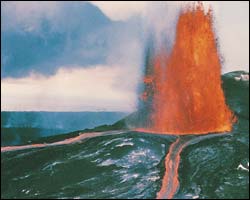 |
|||||||||||||||||||||||||||||||||
|
Volcanoes
The Basics
What is it? Volcanoes are mountains that come in various shapes and sizes, some towering tens of thousands of feet high and others just small domes that rise about 100 feet. Unlike other mountains, though, these natural wonders can erupt with powerful and potentially lethal force. Openings, or vents, in the volcano lead below the earth's surface to very hot chambers several miles underground where there are pools of magma (molten or melted rock), pieces of hot solid rock, and hot gases. Shifts in the earth can build up pressure beneath the volcano. The magma, which is lighter than the surrounding solid rock, is forced upward by the pressure and may ultimately break though, causing a volcanic eruption. A non-explosive, or effusive, volcano produces lava (magma that has erupted
from the earth). An explosive volcano produces ashes. Explosions (without
lava) usually occur first because there are lots of gases inside the magma.
When you open a bottle of soda, bubbles (which are gas particles) escape
first, then liquid can flow; similarly, gas escapes from the magma and,
once the magma is flattened, the liquid lava can flow.
Eruptions can cause lateral blasts (which blow sideways instead of straight up), lava flows, hot ash flows, mudslides, avalanches, and falling ash. Volcano eruptions can knock down forests or trigger flashfloods, earthquakes, mudflows, and tsunamis. The earth's outermost layer, or crust, is made up of a number of shifting tectonic plates. Most active volcanoes are located near the boundaries between these plates. For instance, several plates border each other in the Pacific Ocean Basin, an area where you'll find so many active volcanoes that it's been named the "Ring of Fire." Among the plate boundary volcanoes in this "Ring" is Washington's Mount St. Helens. Volcanologists, scientists
who study volcanoes, believe Mount Rainier in Washington state is the
most dangerous U.S. volcano — it could erupt one day and destroy
areas 50 or more miles away. |
||||||||||||||||||||||||||||||||

